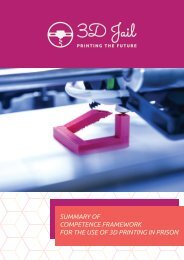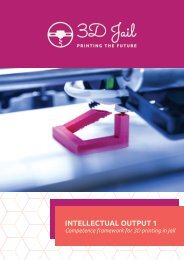Training models for the use of 3D printing technology in prison
3D Jail project further involves a training program for the training and development of trainers who are going to deliver the training program for inmates. Trainers are required to have basic computer, CAM and CAD skills. For the training of the trainers has also been planned an in-service training program to cover information on general characteristics of penitentiary institutions and inmates, use of the e-learning portal, and 3D printing.
3D Jail project further involves a training program for the training and development of trainers who
are going to deliver the training program for inmates. Trainers are required to have basic computer,
CAM and CAD skills. For the training of the trainers has also been planned an in-service training
program to cover information on general characteristics of penitentiary institutions and inmates, use
of the e-learning portal, and 3D printing.
Create successful ePaper yourself
Turn your PDF publications into a flip-book with our unique Google optimized e-Paper software.
Our education system at all levels will redesign processes and structures to take advantage of the
power of technology to improve learning outcomes while making more efficient use of time, money,
and staff.
Current status of advanced technologies in prisons
Advanced technologies, including the Internet, have already been incorporated into the operations of
some penitentiaries. They are used for security and communications monitoring, case management
and data collection, analysis and sharing. In those prisons they are also used to provide incarcerated
individuals with a range of services, including the following:
●
●
●
●
communication with family and friends (i.e., telephone services, e-mail and video
conferencing; see the PRISONCLOUD example below);
video attendance at court hearings and other appointments;
clinical health care, commonly referred to as “telemedicine”;
restricted online banking and money transfers; and online legal research (e.g., Lexus Nexus)
and entertainment.
PrisonCloud is a flexible IT platform designed for the secure distribution of content and
services to inmates. It provides inmate services at any time, in any allowed location
within the controlled prison facility. It allows the inmate to be responsible for his own
life in prison while offering a platform for both entertainment and work. The use of
this system gives the inmate full responsibility over his own life in prison and helps him
or her to become an active and responsible actor during the whole detention process.
It plays a significant part in the normalization process within prison. Life within prison
resembles life in society. With the different services, PrisonCloud can address the
inmates’ full life spectrum from labor & education over leisure, healthcare and
finances to his juridical context. PrisonCloud can be accessed from within the inmate’s
cell but might be installed in other rooms as well. It can be configured to run on diverse
devices. Staff remain in control of the accessible services at all times and can disable
or enable services at any moment. https://www.ebo-enterprises.com/prisoncloud
Advanced technologies are less commonly found or used in prison education programs, however.
Several ERASMUS+ projects and surveys prove that, although most European countries provide
incarcerated students with some form of access to desktop and laptop computers, only few of them
reported that one or more of their high security prisons allowed these students to use tablets in cells.
In terms of computer networking most of the computers were part of a local area network (LAN), only
a few were part of a wide area network (WAN) and almost no facilities have restricted access to the
Internet. However, a lot of prison educational initiatives report to use simulated Internet programs in
one or more of the facilities and some of them gave their instructors access to live Internet technology
in the classrooms.
The primary reason penitentiaries do not provide their education programs and students with
greater access to advanced technologies is security. In fact, most corrections agencies restrict the use
of computing devices to only the classroom or computer lab and have policies barring incarcerated
3DJail printing the future – IO2
6





